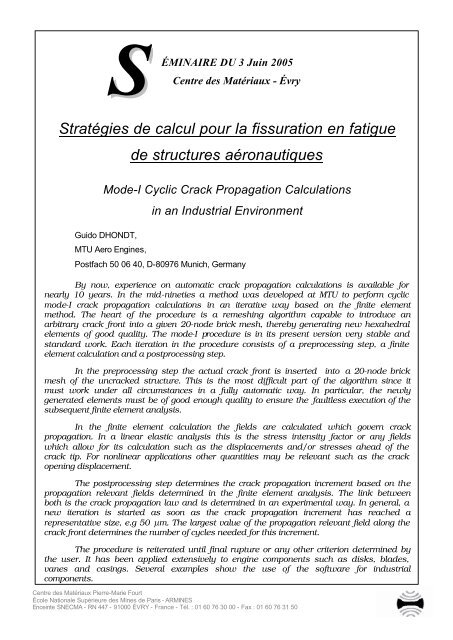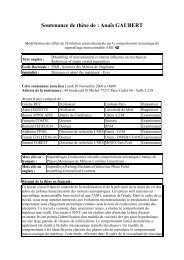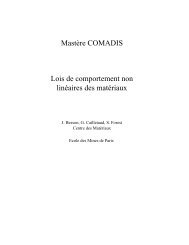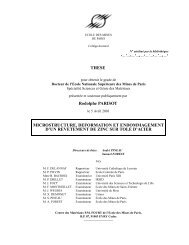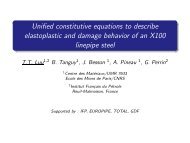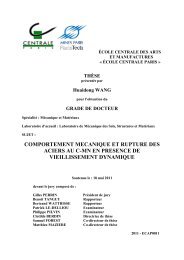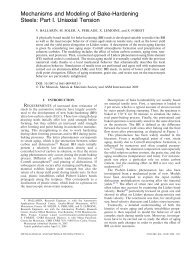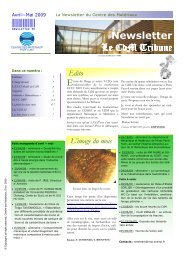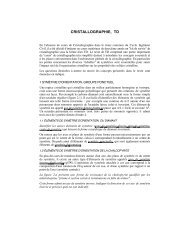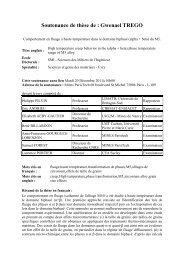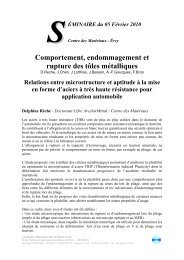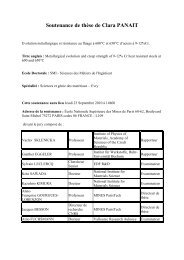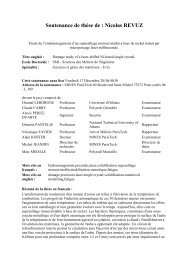Stratégies de calcul pour la fissuration en fatigue de structures ...
Stratégies de calcul pour la fissuration en fatigue de structures ...
Stratégies de calcul pour la fissuration en fatigue de structures ...
You also want an ePaper? Increase the reach of your titles
YUMPU automatically turns print PDFs into web optimized ePapers that Google loves.
S<br />
ÉMINAIRE DU 3 Juin 2005<br />
C<strong>en</strong>tre <strong>de</strong>s Matériaux - Évry<br />
Stratégies <strong>de</strong> <strong>calcul</strong> <strong>pour</strong> <strong>la</strong> <strong>fissuration</strong> <strong>en</strong> <strong>fatigue</strong><br />
<strong>de</strong> <strong>structures</strong> aéronautiques<br />
Mo<strong>de</strong>-I Cyclic Crack Propagation Calcu<strong>la</strong>tions<br />
Guido DHONDT,<br />
MTU Aero Engines,<br />
in an Industrial Environm<strong>en</strong>t<br />
Postfach 50 06 40, D-80976 Munich, Germany<br />
By now, experi<strong>en</strong>ce on automatic crack propagation <strong>calcul</strong>ations is avai<strong>la</strong>ble for<br />
nearly 10 years. In the mid-nineties a method was <strong>de</strong>veloped at MTU to perform cyclic<br />
mo<strong>de</strong>-I crack propagation <strong>calcul</strong>ations in an iterative way based on the finite elem<strong>en</strong>t<br />
method. The heart of the procedure is a remeshing algorithm capable to introduce an<br />
arbitrary crack front into a giv<strong>en</strong> 20-no<strong>de</strong> brick mesh, thereby g<strong>en</strong>erating new hexahedral<br />
elem<strong>en</strong>ts of good quality. The mo<strong>de</strong>-I procedure is in its pres<strong>en</strong>t version very stable and<br />
standard work. Each iteration in the procedure consists of a preprocessing step, a finite<br />
elem<strong>en</strong>t <strong>calcul</strong>ation and a postprocessing step.<br />
In the preprocessing step the actual crack front is inserted into a 20-no<strong>de</strong> brick<br />
mesh of the uncracked structure. This is the most difficult part of the algorithm since it<br />
must work un<strong>de</strong>r all circumstances in a fully automatic way. In particu<strong>la</strong>r, the newly<br />
g<strong>en</strong>erated elem<strong>en</strong>ts must be of good <strong>en</strong>ough quality to <strong>en</strong>sure the faultless execution of the<br />
subsequ<strong>en</strong>t finite elem<strong>en</strong>t analysis.<br />
In the finite elem<strong>en</strong>t <strong>calcul</strong>ation the fields are <strong>calcul</strong>ated which govern crack<br />
propagation. In a linear e<strong>la</strong>stic analysis this is the stress int<strong>en</strong>sity factor or any fields<br />
which allow for its <strong>calcul</strong>ation such as the disp<strong>la</strong>cem<strong>en</strong>ts and/or stresses ahead of the<br />
crack tip. For nonlinear applications other quantities may be relevant such as the crack<br />
op<strong>en</strong>ing disp<strong>la</strong>cem<strong>en</strong>t.<br />
The postprocessing step <strong>de</strong>termines the crack propagation increm<strong>en</strong>t based on the<br />
propagation relevant fields <strong>de</strong>termined in the finite elem<strong>en</strong>t analysis. The link betwe<strong>en</strong><br />
both is the crack propagation <strong>la</strong>w and is <strong>de</strong>termined in an experim<strong>en</strong>tal way. In g<strong>en</strong>eral, a<br />
new iteration is started as soon as the crack propagation increm<strong>en</strong>t has reached a<br />
repres<strong>en</strong>tative size, e.g 50 µm. The <strong>la</strong>rgest value of the propagation relevant field along the<br />
crack front <strong>de</strong>termines the number of cycles nee<strong>de</strong>d for this increm<strong>en</strong>t.<br />
The procedure is reiterated until final rupture or any other criterion <strong>de</strong>termined by<br />
the user. It has be<strong>en</strong> applied ext<strong>en</strong>sively to <strong>en</strong>gine compon<strong>en</strong>ts such as disks, b<strong>la</strong><strong>de</strong>s,<br />
vanes and casings. Several examples show the use of the software for industrial<br />
compon<strong>en</strong>ts.<br />
C<strong>en</strong>tre <strong>de</strong>s Matériaux Pierre-Marie Fourt<br />
École Nationale Supérieure <strong>de</strong>s Mines <strong>de</strong> Paris - ARMINES<br />
Enceinte SNECMA - RN 447 - 91000 ÉVRY - France - Tél. : 01 60 76 30 00 - Fax : 01 60 76 31 50
Etu<strong>de</strong> et modélisation numérique <strong>de</strong> <strong>la</strong> propagation <strong>de</strong>s fissures<br />
dans les aubes <strong>de</strong> turbine<br />
Jean-Luc BOUVARD (DMSE / LCME)<br />
ONERA<br />
29, Av<strong>en</strong>ue <strong>de</strong> <strong>la</strong> Division Leclerc, F-92322 Chatillon Ce<strong>de</strong>x<br />
1. CONTEXTE<br />
L’un <strong>de</strong>s <strong>en</strong>jeux actuels <strong>pour</strong> une meilleure conception, une augm<strong>en</strong>tation du<br />
pot<strong>en</strong>tiel et <strong>de</strong> <strong>la</strong> fiabilité <strong>de</strong>s matériels <strong>en</strong> service consiste à mieux maîtriser les outils<br />
prévisionnels <strong>pour</strong> <strong>la</strong> propagation <strong>de</strong>s fissures dans le régime dit <strong>de</strong>s « fissures courtes »,<br />
<strong>pour</strong> <strong>de</strong>s chargem<strong>en</strong>ts <strong>de</strong> <strong>fatigue</strong> ou <strong>de</strong> <strong>fatigue</strong>-fluage. Cette étu<strong>de</strong> s’inscrit dans le cadre<br />
d’un ambitieux programme <strong>de</strong> recherche europé<strong>en</strong>, SOCRAX, portant sur <strong>la</strong> propagation <strong>de</strong><br />
fissure dans les superalliages monocristallins.<br />
2. OBJECTIFS<br />
Les objectifs <strong>de</strong> <strong>la</strong> thèse sont les suivants :<br />
· Suivi <strong>de</strong> <strong>la</strong> campagne expérim<strong>en</strong>tale sur <strong>la</strong> propagation <strong>de</strong>s fissures courtes<br />
dans les superalliages monocristallins. Ce programme expérim<strong>en</strong>tal prévoit <strong>de</strong>s essais <strong>de</strong><br />
<strong>fatigue</strong> et <strong>de</strong> <strong>fatigue</strong>-fluage, sur éprouvettes puis sur élém<strong>en</strong>ts structuraux.<br />
Mais l’ess<strong>en</strong>tiel du sujet <strong>de</strong> thèse s’inscrit dans <strong>la</strong> partie modélisation numérique<br />
<strong>de</strong> l’étu<strong>de</strong>, avec l’exploitation <strong>de</strong> ces nombreux résultats,<br />
· Etablir un modèle phénoménologique <strong>de</strong> propagation. En effet les modèles<br />
phénoménologiques <strong>de</strong> propagation <strong>de</strong> fissure, qui r<strong>en</strong><strong>de</strong>nt compte à haute température<br />
<strong>de</strong>s effets <strong>de</strong> temps <strong>de</strong> mainti<strong>en</strong> et d’un <strong>en</strong>vironnem<strong>en</strong>t oxydant sur <strong>la</strong> propagation par<br />
<strong>fatigue</strong>, seront ét<strong>en</strong>dus et validés dans le cas <strong>de</strong>s fissures courtes, sur <strong>la</strong> base <strong>de</strong>s<br />
résultats <strong>de</strong> l’analyse numérique et <strong>de</strong> l’expérim<strong>en</strong>tation.<br />
· Développer une méthodologie <strong>de</strong> simu<strong>la</strong>tion numérique <strong>de</strong> propagation <strong>de</strong><br />
fissures, <strong>en</strong> appliquant une approche couplée <strong>en</strong> chargem<strong>en</strong>t cyclique. On s’interessera<br />
plus particulièrem<strong>en</strong>t à l’utilisation d’élém<strong>en</strong>ts d’interface cohésifs, avec une loi <strong>de</strong><br />
comportem<strong>en</strong>t spécifique, <strong>pour</strong> simuler, sans discontinuité, et avec un caractère prédictif<br />
l’avancée d’une fissure.<br />
· Effectuer un reca<strong>la</strong>ge avec l’expéri<strong>en</strong>ce.<br />
C<strong>en</strong>tre <strong>de</strong>s Matériaux Pierre-Marie Fourt<br />
École Nationale Supérieure <strong>de</strong>s Mines <strong>de</strong> Paris - ARMINES<br />
Enceinte SNECMA - RN 447 - 91000 ÉVRY - France - Tél. : 01 60 76 30 00 - Fax : 01 60 76 31 50
3. TRAVAUX REALISES<br />
Durant ces <strong>de</strong>ux années <strong>de</strong> thèse, mes travaux ont plus particulièrem<strong>en</strong>t porté :<br />
· Sur <strong>la</strong> mise <strong>en</strong> p<strong>la</strong>ce et le suivi <strong>de</strong>s essais <strong>de</strong> propagation <strong>de</strong> fissures courtes.<br />
· Sur le développem<strong>en</strong>t <strong>de</strong> modèles <strong>de</strong> zones cohésives :<br />
- implém<strong>en</strong>tation <strong>de</strong>s lois d’interface cohésives, dans le co<strong>de</strong> <strong>de</strong> <strong>calcul</strong><br />
ZéBuLoN, sous chargem<strong>en</strong>t cyclique,<br />
- validation du modèle <strong>de</strong> <strong>fatigue</strong> <strong>en</strong> é<strong>la</strong>sticité et <strong>en</strong> é<strong>la</strong>stoviscop<strong>la</strong>sticité<br />
sur <strong>de</strong>s cas élém<strong>en</strong>taires et sur structure (figure 1),<br />
- développem<strong>en</strong>t d’un modèle <strong>de</strong> zone cohésive pr<strong>en</strong>ant <strong>en</strong> compte le<br />
coup<strong>la</strong>ge <strong>de</strong>s <strong>en</strong>dommagem<strong>en</strong>ts <strong>de</strong> <strong>fatigue</strong>-fluage et les effets d’<strong>en</strong>vironnem<strong>en</strong>t tel que<br />
l’oxydation.<br />
Les travaux vont se <strong>pour</strong>suivre par l’i<strong>de</strong>ntification <strong>de</strong>s paramètres <strong>de</strong>s modèles<br />
numériques, puis par l’établissem<strong>en</strong>t d’un modèle phénoménologique r<strong>en</strong>dant compte, s’il<br />
existe, <strong>de</strong> l’effet <strong>de</strong> l’anisotropie matérielle du monocristal sur <strong>la</strong> vitesse <strong>de</strong> propagation <strong>en</strong><br />
régime fissures courtes, sous condition <strong>de</strong> chargem<strong>en</strong>ts <strong>de</strong> <strong>fatigue</strong> et <strong>de</strong> <strong>fatigue</strong>-fluage.<br />
Figure 1 : traînée p<strong>la</strong>stique <strong>en</strong>g<strong>en</strong>drée par <strong>la</strong> propagation d’une fissure.<br />
C<strong>en</strong>tre <strong>de</strong>s Matériaux Pierre-Marie Fourt<br />
École Nationale Supérieure <strong>de</strong>s Mines <strong>de</strong> Paris - ARMINES<br />
Enceinte SNECMA - RN 447 - 91000 ÉVRY - France - Tél. : 01 60 76 30 00 - Fax : 01 60 76 31 50
3D Crack analysis on complex <strong>structures</strong> by 3D crack insertion.<br />
Francis SONIAK<br />
Messier-Dowty<br />
Zone Aéronautique Louis Breguet, 78140 Vélizy-Vil<strong>la</strong>coub<strong>la</strong>y<br />
e-mail :francis.soniak@messier-dowty.com<br />
The <strong>en</strong>gines and the equipm<strong>en</strong>t of an airp<strong>la</strong>ne are <strong>de</strong>signed in Fatigue in or<strong>de</strong>r to<br />
avoid any case of initiation of cracks. Due to abnormal conditions during specific testing or<br />
in service conditions, crack may occur in certain circumstances. Th<strong>en</strong> the crack propagation<br />
analysis is a powerful tool to validate a minimum life. During that life the whole structure is<br />
still completely safe though the crack have not reach a limit size which is below the critical<br />
size. Moreover this kind of tool is a powerful way for checking and validating the loading<br />
conditions, wh<strong>en</strong> the whole cracking could be analyzed from the initiation .A minimum<br />
inspection life could be fixed during the testing to guarantee the full cell testing integrity.<br />
Initiate several years ago Snecma has got the experi<strong>en</strong>ce of inserting 3D crack in<br />
complex <strong>structures</strong>, by differ<strong>en</strong>t ways and techniques, on the finite elem<strong>en</strong>t mo<strong>de</strong>ling. Ev<strong>en</strong><br />
for complex shapes of cracks, complex thermo-mechanical loadings, for e<strong>la</strong>stic or for e<strong>la</strong>sticp<strong>la</strong>stic<br />
behavior <strong>la</strong>ws, Snecma has <strong>de</strong>veloped internal tools which have be<strong>en</strong> able to<br />
corre<strong>la</strong>te observation on various cases of crack propagation.<br />
Propagation have be<strong>en</strong> studied on numerous cases such as <strong>en</strong>gine disks, gui<strong>de</strong><br />
vanes, turbines cases, seals, …, with a complete success on corre<strong>la</strong>tion crack growth rate<br />
predicted and observed.<br />
This pres<strong>en</strong>tation shows differ<strong>en</strong>t cases of cracks insertion on differ<strong>en</strong>t kind of<br />
<strong>structures</strong>, associated to specific loadings. It shows also the limitations due to the crack<br />
integration, and the way they can be solved on a first approach for <strong>calcul</strong>ating the<br />
associated stress int<strong>en</strong>sity factor.<br />
C<strong>en</strong>tre <strong>de</strong>s Matériaux Pierre-Marie Fourt<br />
École Nationale Supérieure <strong>de</strong>s Mines <strong>de</strong> Paris - ARMINES<br />
Enceinte SNECMA - RN 447 - 91000 ÉVRY - France - Tél. : 01 60 76 30 00 - Fax : 01 60 76 31 50
Propagation <strong>de</strong> fissure <strong>en</strong> <strong>fatigue</strong>-fluage dans les aubes <strong>de</strong> turbine<br />
monocristallines : aspects expérim<strong>en</strong>taux et numériques<br />
Nico<strong>la</strong>s MARCHAL<br />
C<strong>en</strong>tre <strong>de</strong>s Matériaux Pierre-Marie Fourt, UMR 7633, B.P.87, 91003 Evry<br />
nico<strong>la</strong>s.marchal@<strong>en</strong>smp.fr<br />
La simu<strong>la</strong>tion <strong>de</strong> <strong>la</strong> propagation <strong>de</strong> fissure dans les aubes <strong>de</strong> turbine haute<br />
pression est un point prépondérant <strong>pour</strong> l’amélioration <strong>de</strong>s prévisions <strong>de</strong> durée <strong>de</strong> vie <strong>de</strong><br />
ces <strong>structures</strong>. Cette étu<strong>de</strong> s’inscrit dans le cadre du projet <strong>de</strong> recherche europé<strong>en</strong><br />
SOCRAX qui vise à développer <strong>de</strong>s outils numériques permettant <strong>de</strong> simuler explicitem<strong>en</strong>t<br />
<strong>la</strong> propagation <strong>de</strong> fissures courtes dans ces <strong>structures</strong>.<br />
Tout d’abord, <strong>de</strong>s essais <strong>de</strong> comportem<strong>en</strong>t mécanique ont été réalisés afin<br />
d’i<strong>de</strong>ntifier les paramètres <strong>de</strong> <strong>la</strong> loi <strong>de</strong> comportem<strong>en</strong>t <strong>pour</strong> les <strong>de</strong>ux alliages étudiés : AM1<br />
et PWA1483. L’objectif était d’obt<strong>en</strong>ir un modèle robuste, apte à décrire <strong>de</strong>s conditions <strong>de</strong><br />
chargem<strong>en</strong>t très variées. Ensuite, <strong>de</strong>s essais <strong>de</strong> propagation <strong>de</strong> fissure sous air, <strong>pour</strong><br />
différ<strong>en</strong>tes ori<strong>en</strong>tations cristallographiques et différ<strong>en</strong>ts chargem<strong>en</strong>ts (<strong>fatigue</strong>, <strong>fatigue</strong>fluage)<br />
ont été m<strong>en</strong>és. La faible influ<strong>en</strong>ce <strong>de</strong>s temps <strong>de</strong> mainti<strong>en</strong> a été mise <strong>en</strong> évi<strong>de</strong>nce<br />
<strong>pour</strong> l’un <strong>de</strong>s alliages. Des essais sous vi<strong>de</strong> doiv<strong>en</strong>t comm<strong>en</strong>cer <strong>pour</strong> mettre <strong>en</strong> évi<strong>de</strong>nce<br />
l’influ<strong>en</strong>ce <strong>de</strong> l’oxydation sur <strong>la</strong> vitesse <strong>de</strong> propagation <strong>de</strong> fissure. L’oxydation <strong>en</strong> pointe <strong>de</strong><br />
fissure a été étudiée expérim<strong>en</strong>talem<strong>en</strong>t : une éprouvette préfissurée est oxydée<br />
statiquem<strong>en</strong>t à 950°C p<strong>en</strong>dant 300 h : à <strong>la</strong> reprise <strong>de</strong> <strong>la</strong> <strong>fissuration</strong>, on constate une très<br />
forte augm<strong>en</strong>tation <strong>de</strong> <strong>la</strong> vitesse <strong>de</strong> propagation <strong>de</strong> fissure par rapport à l’essai <strong>de</strong><br />
référ<strong>en</strong>ce à 20 Hz. Ceci permet d’estimer <strong>la</strong> longueur <strong>de</strong> <strong>la</strong> zone fragilisée par l’oxydation à<br />
<strong>la</strong> pointe <strong>de</strong> <strong>la</strong> fissure.<br />
Parallèlem<strong>en</strong>t, on a effectué <strong>de</strong>s <strong>calcul</strong>s élém<strong>en</strong>ts finis cycliques <strong>en</strong> pointe d’une<br />
fissure statique, afin d’étudier l’activation <strong>de</strong>s systèmes <strong>de</strong> glissem<strong>en</strong>t. Ceci a servi au<br />
développem<strong>en</strong>t <strong>de</strong> <strong>de</strong>ux modèles <strong>de</strong> propagation qui ti<strong>en</strong>n<strong>en</strong>t compte <strong>de</strong> <strong>la</strong> cristallographie<br />
à proximité <strong>de</strong> <strong>la</strong> pointe <strong>de</strong> fissure. Le premier modèle est non couplé (post-processing). Il<br />
permet d’estimer <strong>la</strong> vitesse d’avancée <strong>de</strong> <strong>la</strong> fissure <strong>pour</strong> un chargem<strong>en</strong>t donné. Le<br />
<strong>de</strong>uxième modèle est couplé : il offre <strong>la</strong> possibilité <strong>de</strong> décrire un chemin <strong>de</strong> fissure non<br />
rectiligne. Ces modèles sont toujours <strong>en</strong> cours <strong>de</strong> développem<strong>en</strong>t.<br />
C<strong>en</strong>tre <strong>de</strong>s Matériaux Pierre-Marie Fourt<br />
École Nationale Supérieure <strong>de</strong>s Mines <strong>de</strong> Paris - ARMINES<br />
Enceinte SNECMA - RN 447 - 91000 ÉVRY - France - Tél. : 01 60 76 30 00 - Fax : 01 60 76 31 50


